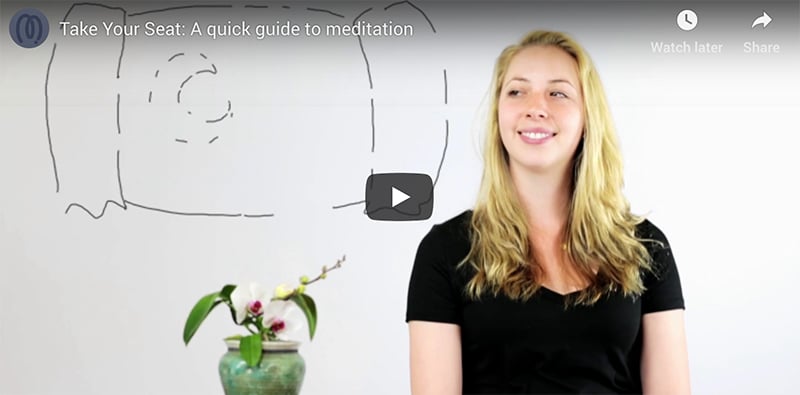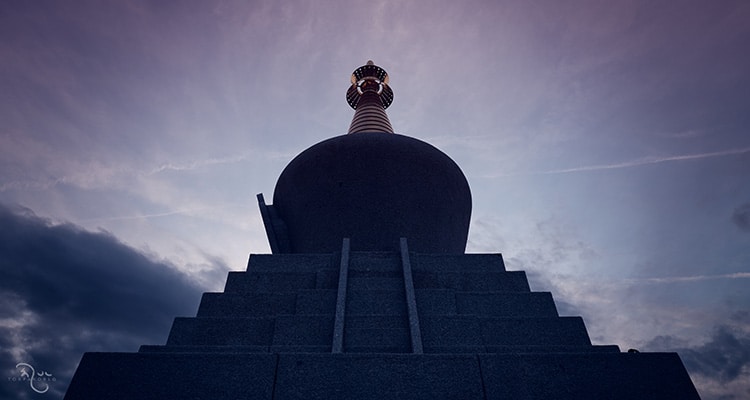Sitting Meditation Demystified
Category: How to Meditate

Is strong determination required for sitting meditation? If determination spells persistence, then the answer is yes. Most everyone agrees that you’ll get the most out of your meditation practice if it’s regular – when possible, daily is best. But if you think determination means that you absolutely have to sit still for hours at a time, think again. Even 5 minutes a day of dedicated practice can yield results. And just about everyone who devotes a few minutes a day ends up wanting to do more, whether longer sitting sessions or more frequent short ones interwoven into a busy day.
Wherever you are in your meditation practice, how you sit will make a big difference in your ability to establish and gradually extend your sessions.
Types of sitting postures and positions
Some meditation poses involve sitting on a chair while others involve sitting or kneeling on a cushion or mat. In all cases, the back is straight, the chin tucked in, and the hands are either settled on the thighs above the knees, palms down, or in the meditation gesture with the right hand resting on the left, two thumbs touching, held below the navel or resting on the lap. The eyes should be half open, gazing comfortably down in front, or closed.
Here’s a look at some of the better-known sitting postures:
- The Lotus Positions
These meditation positions from the East are quite popular in the West. There are basically three lotus positions: the quarter lotus, the half lotus and the full lotus. All of these poses involve sitting in a cross-legged position but differ slightly. In the quarter lotus, the right foot should rest on the calf of the left leg which is flat on the ground with the left foot pulled in towards the pelvis. This is a relatively comfortable position. In the half lotus, the right foot is pulled closer to the body and rests on the left thigh. Here too the left leg is on the ground, folded with the left foot close to the pelvis.
The full lotus has the knees touching the ground or mat and both feet resting on the opposite thighs. Begin with the half lotus as above, then pull your left foot up so that your calves are crossed and your left foot is resting on your right thigh. This is probably the most difficult of the sitting postures and most meditators have to adjust to it slowly. It does provide great stability and energy flow, and those who are able to maintain the full lotus swear by it.
In all forms of the lotus or any other posture where you are on the ground, you may choose to sit on a cushion or pillows if it’s more comfortable for you.
- Chair
Using a chair (or any kind of meditation furniture) is completely okay. This is especially recommended if you’re just starting out or are physically uncomfortable when seated on a mat. Some meditators prefer sitting on a chair because it’s easier and doesn’t strain the knees.
When physically possible, it’s best not to lean against the back of the chair since you’re more likely to remain alert and aware when your body is erect and your back is straight. Plant your feet on the ground a foot or so apart. Your knees should not be higher than your hips.
- The seiza pose
Some meditators prefer kneeling instead of sitting. This posture, the seiza pose, originated with Buddhist practitioners in Japan. You place a towel, cushion or soft material between your thighs and calves. Next, assume a kneeling position. Check in with your physical posture and make sure that your back is straight and your muscles are relaxed as you begin meditating.
You can kneel on a mat or cushion to support your legs, and many people like to kneel with a meditation bench or cushion under the buttocks to help support and align the back. Comfort is key, so make sure you’re comfortable before settling into a meditation posture.
- The Burmese position
This is one of the easiest postures to manage if you’re sitting on the floor. It’s similar to the quarter lotus except that here both feet are on the mat, with the left foot closest to the body and the right leg pulled close against the left. The tops of both feet are touching the mat. Try to keep your back straight throughout your meditation.
The Burmese position is also referred to as the Easy Pose. For longer sessions, keeping the spine aligned requires extra attention, but other than that it’s generally accessible to anyone who doesn’t have knee issues.
You can experiment with these four essential postures during your daily meditation. For additional resources, check out our these other blog posts: The Best Meditation Posture for You and the Top 5 Buddhist Meditation Postures. And for basic sitting pointers, check out our Take Your Seat video:







